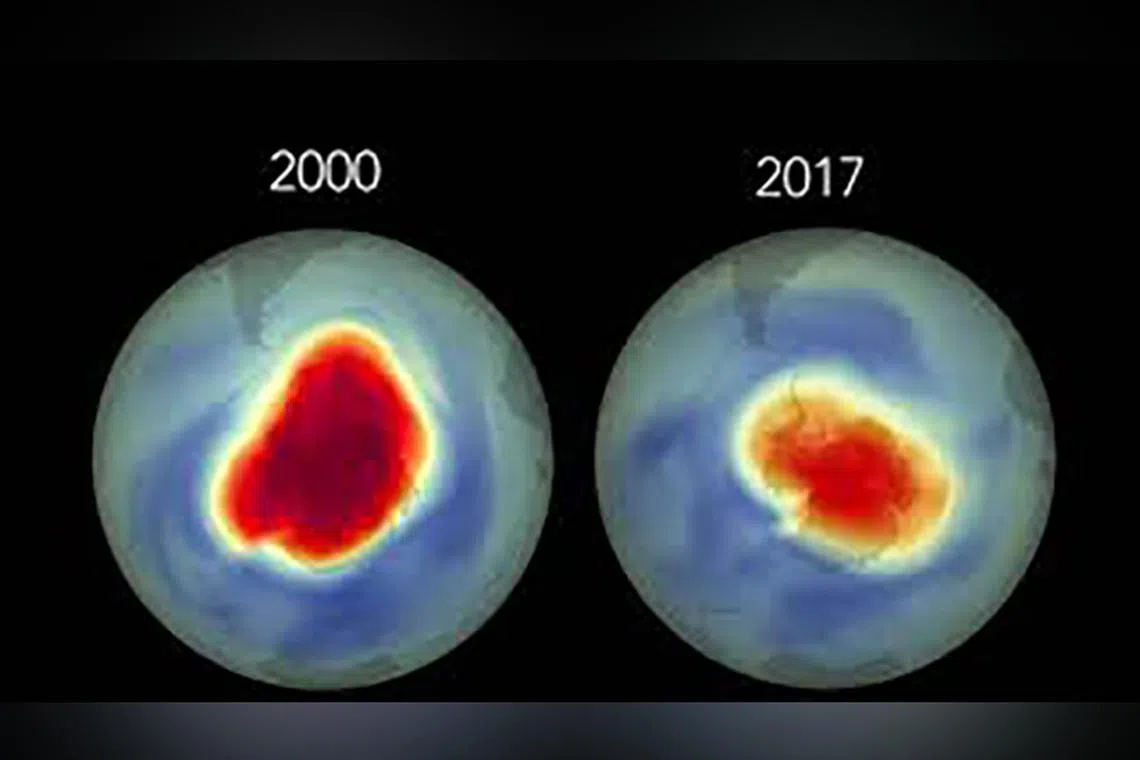Earth’s ozone layer to heal within decades: UN report
Sign up now: Get ST's newsletters delivered to your inbox

A Nasa image shows how the Antarctic ozone hole has decreased in size between 2000 and 2017. Red and orange sections indicate where ozone levels are the lowest.
PHOTO: NASA
Follow topic:
SINGAPORE – In a rare piece of good news for the environment, a United Nations-backed panel of experts has stated that the earth’s ozone layer is set to recover within decades.
The report
As for the Arctic and Antarctic, ozone levels would recover around 2045 and 2065 respectively.
Commenting on these findings, Associate Professor Adrian Michael Lee of the Department of Chemistry at the National University of Singapore said the return of total column ozone (TCO) to 1980 levels means that the ozone layer would have been restored to the state before the appearance of the Antarctic Ozone Hole, first discovered in 1985.
TCO is a measurement of the total amount of ozone in a given column of the atmosphere stretching from earth to space.
Because the ozone layer prevents harmful ultraviolet radiation from reaching the earth’s surface, a return of TCO to 1980 levels signifies an abatement of the increased risk of skin cancer for people living in temperate latitudes, though it does not make as big an impact to equatorial locations like Singapore, said Associate Professor Koh Tieh Yong. He is a weather and climate scientist at the School of Science and Technology at the Singapore University of Social Sciences.
The report linked the recovery of the ozone layer to the successes of the Montreal Protocol, which was adopted in 1987. It regulates the production and consumption of nearly 100 chemicals known as ozone depleting substances (ODS).
These ODS include chlorofluorocarbons (CFC) which are commonly used in refrigerants and aerosol sprays.
When these substances enter the stratosphere, they set off a series of chain reactions that break down the ozone layer. In addition, many ODS are greenhouse gases that exacerbate climate change.
In 2016, countries also adopted the “Kigali Amendment” to the Montreal Protocol, which committed them to reduce the production and consumption of hydrofluorocarbons (HFC). Though they do not cause ozone depletion, they too are powerful greenhouse gases and contribute to global warming, added Prof Lee.
The report noted that by phasing down ODS and HFC, the protocol has helped to avoid an additional 0.5 - 1 deg C of global warming, as compared to an extreme scenario where emission levels increased by 3 - 3.5 per cent each year.
As a signatory to the treaty, Singapore has implemented control measures. For example, from 2022, the National Environment Agency banned the supply
However, the report also highlighted certain outstanding scientific and policy challenges. Though 99 per cent of banned ODS have been phased out, emissions of certain CFC and other gases such as nitrous oxide (N2O) have increased. N2O is not currently regulated under the Montreal Protocol.
Said Prof Lee: “Overall, the global community has made great strides to eliminate the consumption and production of ozone depleting substances. There remains an enforcement issue in certain countries, notably China.”
“The Chinese government has faced significant challenges enforcing regulations that ban the use of CFC and other ozone depleting substances,” he added.
“Observations suggest that those challenges still exist, but hopefully they will be resolved. The international community needs to stay vigilant and ensure that member countries meet their obligations under the protocol,” he said.

A Nasa image which shows the ozone hole over Antarctica on Oct 5, 2022. Blue and purple sections indicate where there is the least ozone.
PHOTO: NASA
Prof Koh noted that in Singapore, the main sources of N2O are fossil fuel combustion in power generation and transportation sectors, and to a lesser extent, the use of fertilisers.
He noted that though the Republic is already moving towards the adoption of renewable energy, it is also important to evaluate the impact of the increased use of fertilisers in urban farming on national N2O emissions. The nation has a 2030 goal of achieving 30 per cent self-sufficiency in food.
Moreover, the study cautions against the use of Stratospheric Aerosol Injection (SAI). It stated that the geoengineering strategy could cause additional ozone depletion over Antarctica, though there are currently significant uncertainties in modelling its impact.
SAI seeks to inject large amounts of reflective particles into the stratosphere. These would then send incoming sunlight back to space, limiting the rise of temperatures.
First proposed by Russian climatologist Mikhail Budyko in 1974, the technique is being researched Several experiments on the strategy
Although Singapore is not currently pursuing SAI, in 2022, during a dialogue with the Council on Foreign Relations, an American think-tank, Prime Minister Lee Hsien Loong said he “would be prepared to do some pilot projects” on geoengineering, including SAI.
Prof Lee said that despite these prevailing issues, the Montreal Protocol has strongly influenced other international environmental agreements, not least the Kyoto Protocol and the Paris Agreement, in particular through its adherence to the precautionary principle and the principle of equity.
The precautionary principle argues that where there are threats of serious or irreversible damage, lack of scientific certainty should not be used as a reason for postponing measures to prevent environmental degradation.
The protocol also incorporated equity since its inception by identifying later dates for developing nations to phase out CFC than developed nations, recognising the added assistance that the former group needed, he added.
Prof Koh also said: “With political will based on science evidence, it is possible to achieve international agreements that regulate economic activities to avert environmental disasters and improve the well-being of human societies. This reflects a hopeful side of our human nature.”

